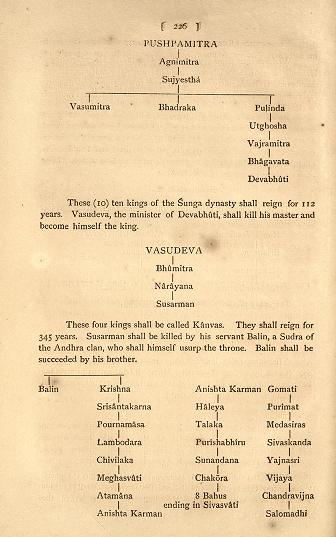Andhra
Andhra (आंध्र)(/आन्ध्र) Andhrana (आंध्राणा)/(आन्धराणा)[1] is Jat gotra of Chandravanshi Kshatriyas.
Origin
It gets its name from Andhra rulers rulers. They were branch of Yadavas. [2]
There has been mention of Andhra rulers numbering 22 in Shrimad Bhagwat, 24 in Vishnu Purana, 30 in Matsya Purana. they have been mentioned as Andhra/Andhrabhratya there. They are descendant of samrat Yayati's great grandson Dirghatama's (दीर्घत्तमा) son Andhra (आंध्र).
In Bhagavata Purana

'A study of the Bhagavata Purana; or, Esoteric Hinduism' by Purnendu Narayana Sinha, pp 226-227 mentions that (10) ten kings of the Sunga dynasty shall reign for 112 years. These are:Pushyamitra → Agnimitra → Sujyestha → (Vasumitra + Bhadraka + Pulinda): Pulinda → Utghosha → Vajramitra → Bhagavata → Devabhuti
Vasudeva, the minister of Devabhuti, shall kill his master and become himself the king.
- Vasudeva → Bhumitra → Narayana → Susarman
These four kings shall be called Kanvas. They shall reign for 345 years. Susarman shall be killed by his servant Balin, a King of the Andhra clan, who shall himself usurp the throne. Balin shall be succeeded by his brother Krishna (Balin + Krishna). The genealogy of Krishna is:
Krishna → Srisantakarna → Pournamasa → Lambodara → Chivilaka → Meghasvati → Atamana → Anishta Karman → Haleya → Talaka → Purishabhiru → Sunandana → Chakora → 8 Bahuka or Bahus ending in Sivasvati → Gomati → Purimat → Medasiras → Sivaskanda → Yajnasri → Vijaya → Chandravijna → Salomadhi [Page-227 ]
These thirty kings of the Andhra dynasty shall rule the earth for 456 years.
In Ramayana
Ramayana - Kishkindha Kand Sarg 41 mentions about Andhras as under:
तथा वन्गान् कलिन्गाम् च कौशिकान् च समंततः ।
अन्वीक्ष्य दण्डक अरण्यम् स पर्वत नदी गुहम् ॥४-४१-११॥
नदीम् गोदावरीम् चैव सर्वम् एव अनुपश्यत ।
तथैव आन्ध्रान् च पुण्ड्रान् च चोलान् पाण्ड्यान् केरलान् ॥४-४१-१२॥
In Mahabharata
Bhisma Parva, Mahabharata/Book VI Chapter 10 mentions geography of Bharatavarsha:
- "Andhras, and, O king, many hilly tribes, and many tribes residing on lands laying at the foot of the hills, and the Angamalajas, and the Manavarjakas (Maan)+(Bardak); "
- अन्ध्राश च बहवॊ राजन्न अन्तर्गिर्यास तदैव च
- बहिर्गिर्य आङ्गमलदा मागधा मानवर्जकाः (Maan+Bardak) Mahabharata (6.10.48)
Sabha Parva, Mahabharata/Book II Chapter 28 mentions the provinces sabjugated by Sahadeva, who marched towards the southern direction. The hero brought under his subjection and exacted tributes from the Paundrayas, and the Dravidas along with the Udrakeralas and the Andhras and the Talavanas, the Kalingas and the Ushtrakarnikas.
- पाण्ड्यांश च थरविथांश चैव सहितांश चॊथ्र केरलैः
- अन्ध्रांस तलवनांश चैव कलिङ्गान ओष्ट्र कर्णिकान Mahabharata (2.28.48)
The Mahabharata Tribe - Andhra (अन्ध्र) , A very ancient tribe, mentioned as Dasyus in the Aitareya Brahmana (VII.18), as the result of a curse by Vishwamitra. Linked with Pulinda, Khasa, Nishada and other low peoples, they fought for Duryodhana (VIII. 51.17). The Mbh. (XII.200.40) describes them as natives of the south. (VI.10.48)
- अन्ध्राश च बहवॊ राजन्न अन्तर्गिर्यास तदैव च
- बहिर्गिर्य आङ्गमलथा मागधा मानवर्जकाः (VI.10.48)
- The Mahabharata Tribe - Andhra (अन्ध्र) may be identified with Jat Gotra - Taka or Takhar, Name of their tribe was Andhra. [3]
- According to Thakur Deshraj there was a great king in Andhra-vansh named Hala around 69 AD. The descendants of Maharaja Hala came from south to north and settled in uttar Pradesh and Rajasthan. The Jat groups of these Kshatriyas were known as Hala.[4]
- The Mahabharata Tribe - Andhra (अन्ध्र) may be identified with Jat Gotra - Andar (अंदार) or Andara (अंदार) is Jat gotra same a Andhak. [5]
- The Mahabharata Tribe - Andhra (अन्ध्र) may be identified with Jat Gotra - Andhrana (आंध्राणा).[6]
- The Mahabharata Tribe - Andhra (अन्ध्र) may be identified with Jat Gotra - Vadiar (वाडियार) .[7]
See also
References
- ↑ Jat History Dalip Singh Ahlawat/Parishisht-I, s.n. आ-2
- ↑ Mahendra Singh Arya et al.: Ādhunik Jat Itihas, p.222,s.n.6
- ↑ Dr Naval Viyogi: Nagas – The Ancient Rulers of India, p.144
- ↑ Jat History Thakur Deshraj/Chapter VIII, p. 559
- ↑ Mahendra Singh Arya et al.: Ādhunik Jat Itihas,
- ↑ Mahendra Singh Arya et al.: Ādhunik Jat Itihas, p.222
- ↑ Mahendra Singh Arya et al.: Ādhunik Jat Itihas, p. 267
Back to Jat Gotras

